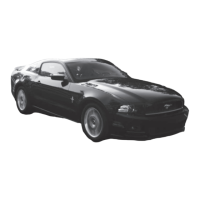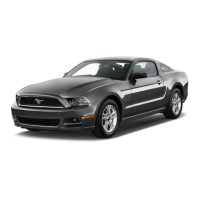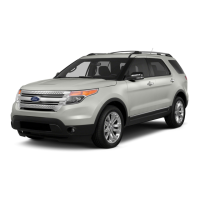
Do you have a question about the Ford 2014 MUSTANG and is the answer not in the manual?
| Brand | Ford |
|---|---|
| Model | 2014 MUSTANG |
| Category | Automobile |
| Language | English |
Explains manual structure, environmental responsibility, and system information.
Details the function and data recorded by the vehicle's event data recorder (EDR).
Covers California Proposition 65, Ford Credit, parts recommendations, and mobile communication safety.
Provides general information and recommendations for child safety restraints.
Details child seat positioning, attachment methods, and booster seat usage.
Explains the LATCH system and proper tether strap installation procedures.
Covers basic operation, system components, restraint warnings, and pregnant women's safety.
Explains the seat belt warning light, chime, and Belt-Minder® feature operation.
Details periodic inspection and maintenance of safety belts and child seat systems.
Introduces the SRS, its components, and how it adapts to occupant and crash conditions.
Outlines airbag safety principles, deployment risks, and system characteristics.
Explains the passenger sensing system, object detection, and potential effects of modifications.
Describes side airbag locations, operation, and the role of crash sensors.
Details FCC compliance, operating range, and factors affecting remote control range.
Covers car finder, panic alarm, and replacing the transmitter battery.
Explains how to purchase and program replacement keys or remote controls.
Introduces MyKey functionality, standard settings, and optional configurations.
Provides instructions for creating, programming, and clearing MyKey settings.
Details how to check MyKey status and common troubleshooting solutions.
Discusses MyKey compatibility with aftermarket remote start systems.
Covers power door locks, remote control, trunk, smart locks, and autolock/autounlock features.
Explains interior trunk control lockout, manual release, and battery saver functions.
Details the SecuriLock system, including automatic arming and the anti-theft indicator.
Explains how to arm, disarm, and trigger the active anti-theft system.
Covers procedures for replacing and programming spare keys for the security system.
Provides instructions for adjusting the steering wheel's tilt and reach.
Details operation of audio, voice control, and information display controls.
Explains how to use windshield wipers and their basic maintenance.
Describes how to operate the windshield washer system and its functions.
Covers the main lighting control dial, high beams, and headlamp flasher.
Explains the autolamp system and how to adjust headlamp exit delay.
Details the operation of daytime running lamps and front fog lamps.
Describes interior lighting controls and turn signal indicators.
Covers power window operation, one-touch features, and bounce-back functionality.
Explains adjustment and features of exterior and interior mirrors.
Details the use and function of sun visors and the sunshade system.
Provides an overview of the main gauges and indicators in the instrument cluster.
Details the meaning and function of various warning lamps and indicators.
Explains indicators for stability control, service engine soon, and speed control systems.
Lists and explains various audible warnings and indicators.
Covers general display use, controls, and trip computer functions.
Details features like oil life, steering feel, lighting, and color customization.
Explains Type 2 controls, main menu, and troubleshooting common display issues.
Outlines crucial safety measures and guidelines for fuel quality and selection.
Covers refueling with portable containers and the Easy Fuel® system.
Explains fuel economy calculation and emission control system requirements.
Details the OBD-II system, malfunctions, and Inspection/Maintenance testing readiness.
Covers automatic transmission positions, SelectShift, and brake-shift interlock.
Explains manual transmission operation, clutch use, and recommended shift speeds.
Details how to park the vehicle and use the hill start assist feature.
Discusses normal brake noise and when to seek inspection.
Covers procedures for stuck accelerator and the operation of the ABS.
Explains how to set and release the parking brake.
Explains how traction control works and when to turn it off for better performance.
Discusses stability control principles and how vehicle modifications affect its performance.
Details how the AdvanceTrac® system operates and its available features.
Covers the parking sensing system's operation, limitations, and sensor maintenance.
Explains the rear sensing system and the rear view camera system's functionality.
Outlines cruise control principles, how to use it, and setting speed.
Details how to change set speed, cancel, resume, and turn off cruise control.
Describes the electric power steering system, its diagnostics, and steering tips.
Explains how to select different steering feel modes (Standard, Sport, Comfort).
Defines terms like Base Curb Weight, Vehicle Curb Weight, Payload, and Weight Ratings.
Provides steps and examples for calculating available cargo and luggage load capacity.
Offers guidelines for trailer towing, load placement, and safety practices.
Covers recommended towing weights, essential checks, and trailer brake/lamp systems.
Discusses towing the vehicle on four wheels and recreational towing.
Provides step-by-step instructions for opening the convertible top.
Details how to install and store the convertible top boot.
Offers instructions for properly closing the convertible top.
Offers advice on breaking in new tires and improving fuel economy.
Explains the risks and precautions when driving through water.
Covers proper installation and safety precautions for floor mats.
Outlines the complimentary roadside assistance program available in the U.S. and Canada.
Explains hazard flasher operation and the fuel cut-off switch function.
Provides instructions for jump-starting a vehicle and essential battery safety information.
Guides on getting vehicle service and finding authorized dealers.
Details warranty dispute processes, California Lemon Law, and BBB Auto Line.
Instructs on how to report safety defects to NHTSA (U.S.) and Transport Canada (Canada).
Lists standard fuse amperage ratings and their corresponding colors.
Details high-current fuses in the power distribution box and protected components.
Shows the fuse panel layout in the passenger compartment and protected components.
Covers general maintenance, precautions, working with the engine off, and under-hood component identification.
Provides instructions for checking and adding engine oil, coolant, and servicing the battery.
Covers air filter replacement, wiper blade care, headlamp adjustment, and bulb replacement procedures.
Explains tire quality grades (Treadwear, Traction, Temperature) and glossary terms.
Details information on tire sidewalls and requirements for tire replacement.
Covers safe tire practices, highway hazards, and inspection for wear and damage.
Explains the TPMS operation, warnings, and malfunction indicators.
Guides on changing a road wheel, using a dissimilar spare, and temporary tire repair.
Introduces SYNC, safety warnings, and privacy information.
Covers pairing phones, making calls, and using voice commands for phone functions.
Details SYNC applications like 911 Assist, Vehicle Health Report, and SYNC Services.
Provides solutions for common phone and media connectivity problems with SYNC.
Explains navigation controls, display modes, and home screen customization.
Covers AM/FM radio, HD Radio, SIRIUS, CD/DVD, and Jukebox functionality.
Guides on programming destinations via voice/touchscreen and route selection preferences.
Details map display options, route preferences, traffic information, and guidance settings.
Contains end-user license agreements for software and important user notices.
Outlines intellectual property rights, export restrictions, and user responsibilities.











